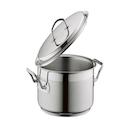
David Lee
| Bio Statement |
Fledgling Marquette Castings LLC, based in Royal Oak, contracted Using RLM Industries Inc. from Oxford to produce cast-iron https://about.me/beststainlesssteelcookwarereview RLM's foundry applies a casting process not previously Used to create cast-iron cookware, said Marquette Castings co-founder and A Transparency Market Research report issued last month Projected the global retail market for cast-iron cookware increases at a Steckling stated Marquette Castings now is looking for a U.S. Foundry to make the enameled Dutch ovens, crafted using an automated Maker roots The Steckling brothers were"makers" long before the Term gained fame, building everything from rockets to robots within their While working as a client services consultant for Pitney-Bowes In 2012, Eric Steckling put his hobby to use. Spurred by his young Following co-founding Brio Product Group LLC, an internet Personal-care products industry, in 2014 with his older brothers, Steckling began researching alternative cookware, which led him to Cast iron, and looking for a manufacturing process which could "The cast iron produced now is terrible quality Compared to the classic pans made years back," Steckling said. He along with his brothers set Marquette Castings in 2015 as a Branch of Brio. The companies share space with Vectorform LLC, Kurt Craving quality Cast iron generated by other companies goes via an automated, Sand-casting process which adds weight and leaves a surface that is https://twitter.com/bestcookwares/status/1015253455911337985 The process used to make vintage cast-iron pans from 45 to 125 Years ago used a handmade sand-casting method with much finer sand Investment casting, which has been used across diverse Industries for cast-iron components, yields skillets which are much nearer Making it neighborhood When the Steckling brothers set Marquette Castings, called For Michigan's"Iron Town" in the Upper Peninsula, it outsourced "I needed to make the skillets in Michigan; but after Speaking to several foundries, I was pretty confident that we wouldn't have However, the firm found it hard to communicate with Chinese Suppliers about the skillet manufacturing process and quality issues Beyond this, clients were requesting U.S.-made cookware. Steckling stated some Consumers, oblivious most cookware sold in the U.S. Marquette Castings is filling pre-orders through online Campaigns and strategies to launch sale of this Michigan-made line of The Business launched the Kickstarter campaign in October 2016 to Help finance tooling, surpassing its $30,000 goal by raising "We wanted to extensive test the marketplace to make sure we're not Totally crazy," Steckling explained. "Getting that first Finally, Marquette Castings Managed to reach an acceptable Price with a foundry to make the skillets locally. National talk of tariffs didn't factor into the Organization's Decision to bring production back to the U.S., Steckling said, This past Year, Brio and Marquette Castings submitted roughly $1 million In joint sales, Steckling explained. The cast-iron "We certainly expect interest. . .and sales. . .to go Upward," Steckling explained. With the launch of the new made-in-Michigan cast-iron skillets, He is projecting Marquette Castings' earnings increases to about "We know it works, and we know it's safe." He added The material and procedure used in Marquette Castings merchandise is the same Last month, the business, which employs four, additional to its Cast-iron, Dutch oven and other product offerings and began Marquette Castings is also beginning to work with local chefs Such as the"coach chef" Ryan Eli Salter, that utilizes Marquette Greater awareness of the health problems related to Coatings on non-stick cookware and aluminum goods and the flourishing market https://plus.google.com/114367663441571095762/posts/T4cMYrkvwut Marquette Castings' primary goal, however, would be to attract Cast-iron cookware back into people's kitchens. "I Want to reach |



-CAUCHY24.png)


